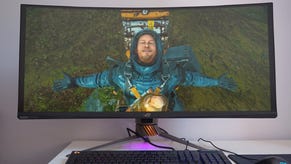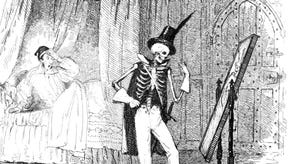How turns make Thumper feel physical
Play the pattern
This is The Mechanic, where Alex Wiltshire invites developers to discuss the inner workings of their games. This time, Thumper [official site].
“When people say they’re injuring their thumbs it’s too bad, but it’s kind of the best compliment you can ever get,” says Thumper’s co-designer and artist, Brian Gibson. “It means their nervous system is on fire when they’re playing.”
Thumper is a game that you feel. As you hurtle down its sliver of track, every twist, scrape and jump has a physicality that transcends its fundamental nature as a call-and-response rhythm game. You can only really play Thumper once it’s bashed its way into your subconscious, when the lights and booming sound of the abstract hell you’re flying through can brutalise your brainstem into remembering patterns of threats. And the threats that get to you, the ones that really make your fingers claw the pad, are:
THE MECHANIC: Turns
To a game like Thumper turns feel like a given, but like so many things about its seven-year development, they’re a result of evolution. Gibson and programmer Marc Flury previously worked at Harmonix, where they helped make Amplitude, Guitar Hero and Rock Band. But when they left to form Drool, their initial vision was to rebel against what they'd been working with for so long.
“I was looking at music games and feeling like the track that goes in one direction infinitely was this abstraction that was kind of boring,” Gibson says. “I was thinking there must be a way to make that abstraction into something that’s more tangible and feels like you’re in this world rather than playing a piano on a roll, which just feels unsatisfying and uninteresting.”
“I thought it’s like a rhythm game but really simple and the difference is that it’s more about space,” says programmer Marc Flury. First prototypes allowed you to move across a grid and you could fall off it if you didn’t steer around its bends. “It was really not about beats but about speed and gamefeel, and that’s what we were adding to the normal rhythm game recipe.”
They quickly realised that turns added something else to that recipe: they could obscure the view ahead, introducing new tension to a level. But they maybe went a little too far with this idea to start with in making all of the turns right angles. Very hard to play, they began reducing the angle (“every year it’s like we reduced that 90 degree angle by like 10 or 20 degrees,” says Gibson) and realised that a more important thing about turns is how they relate feelings of tearing around or smashing into them.
“We got so much into the idea that the game was going to be physically plausible, and these super sharp turns were outrageously unrealistic,” says Gibson. It sounds kind of mad, given that you play as a little chrome space beetle and you defeat skeleton horrors made of light by going really fast. But making turns feel plausible helps generate the sense of being there that’s so strong in Thumper, something that’s further enhanced by the controls.
The first version of the controls worked as you’d expect: press the direction at the right time; fail and you’d fall off. But then Drool added the need to hold a button as well as the direction in order to turn. “I think that’s really important because for one thing it’s getting away from the idea of being a rhythm game and being about processing cues and each one maps to a button,” says Flury. It was inspired by Mario Kart’s power slides, where you’d hold a button to hop and turn into a slide that gives control over the turn without losing speed.
So when you push the button you’ll see the beetle tuck its legs in and tighten its shell a little, and then, as you push the direction, it banks into the turn without taking damage. “Even though we could have it more intuitive or easier to teach, if we just had it be the direction the sensation would feel too light, not as good,” says Flury. “We wanted to have both of those sensations, of leaning on the side and bracing for impact, and this was the simplest control scheme we could come up with that represented both states.”
Adding the button also opened up various new challenges. When you have it held, you feel safe, able to take any turn. But sometimes you need to let go, to hit notes or to switch lanes, and this can make you feel awfully vulnerable. Often, point-giving rings are placed right before a turn so you have to release and press to grab them.
The button is also intrinsic to performing perfect turns. Tallied at the end of sections, they’re achieved by having one input held before the turn - usually the button - and then hitting the second - usually the direction - right as the turn begins. Accompanied with a little chime, they feel great to pull off, and if you’re flying when you trigger one, you’ll continue your flight through the turn and feel even better.
“In the beginning I was pretty down on perfect turns,” says Gibson. “In the beginning I was overly preoccupied with absolute simplicity, no extra features or bells and whistles. Over time it grew on me and I realised that it does make the game better and definitely now with the perfect turns, making it so you can continue your flight is such an intrinsically cool thing that changes how people play and strategise high scores. It’s a huge part of the game now, for experts at least.”
There are subtleties to turns, too. You might know they make distinct sounds when they appear on the horizon, helping you prepare on some mental level. But you might not realise that there are different sounds for left and right turns. “I didn’t want it to sound like two different sounds, but there’s this hope that there will be someone who’s blind and is super-sensitive to all the nuances of the cues they’re hearing and can actually play the game just by listening,” says Gibson. But he feels it doesn’t quite work in practice, because to prevent identical sounds from being wearyingly repetitive, he randomised their pitches, making them harder to identify from the rest of the soundscape.
And he’s not so happy about the intensity of that soundscape, either. “I think the problem for me was that I tend to want to fill up every frequency. I don’t know if you’ve heard the band I’m in; I want my music to be super-full and fill every frequency. I feel that part of maturing is learning how to put spaces in the right places and to allow things to be quiet and have space. One of the weaknesses of this game for me is that I tried to make every sound the most loud and punishing, full-frequency intense sound and I wasn’t thinking about how to leave space for the turn sound. I wasn’t being strategic about how to divide up the frequency ranges and fit everything together. I feel like the game is a barrage of super-intense -“
But this, of course, is a big part of Thumper’s character. “Yeah, it’s part of its character and it’s cool, but the next game we do I want to be more nuanced about the audio.”
Some features make turns work in a practical sense, too. The game doesn’t fail a turn if you release the inputs early, and it adjusts the thresholds for a correct input in situations such as when a player is holding down for a pound before a turn, because they tend not to push the stick around to the left or right as far as they usually would. More notably, turns come with a lenient 200ms timing window, so that as long as you’re pressing both inputs you won’t take damage. “It always seemed so generous, but Brian was really adamant about keeping that. It still feels tight and it’s just about making the game not be about being so precise,” says Flury.
“We want to reward people for really understanding the pattern or the larger context of what they’re in,” says Gibson. “I feel precision is not really what music is about. Music is about being conscious of the larger pattern that you’re inside of. Maybe there’s people who are not precise, but they really feel it and really respond to what’s coming at them. You don’t want to punish those people because they’re early or late, you want to reward them for not losing their bearings when a lot of stuff is flying at them.”
And staying calm in the storm is what Thumper is about. Feel the pattern; play the pattern; hold on to those buttons for dear life.












